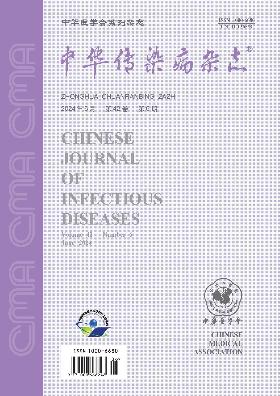Epidemiological characteristics and etiology analysis of 11 510 hospitalized children with hand, foot, and mouth disease
引用次数: 0
Abstract
Objective To study the prevalence trends and etiology of hand, foot, and mouth disease (HFMD) in hospitalized children. Methods The clinical data of 11 510 cases of children hospitalized with HFMD from 2008 to 2017 in Department of Infection Diseases of Kunming Children′s Hospital were collected, and to retrospectively analyze the characteristics, time distribution and pathogen distribution of the cases. Results Of the 11 510 children with HFMD, 6 100 were male and 5 410 were female. There were 9 814 cases under 3 years old, 1 696 over 3 years old. HFMD occurred throughout the year. The peak months of the disease were April to July, with the time distribution of single peak. There were 4 690 severe cases and 3 452 critical cases, accounting for 70.34%. The main pathogens detected were enteroviruses A71 (EV-A71), coxsackievirus A16 (CV-A16) and other enteroviruses (EV), with 3 803 cases (36.02%), 1 122 cases (10.63%) and 3 401 cases (32.21%) respectively. EV-A71 and CV-A16 infections dominated from 2008 to 2013, while EV-A71 and other EV infection dominated from 2014 to 2017. Conclusions EV-A71, CV-A16 and other EV are the main pathogens of HFMD in Kunming. Critical HFMD cases are mainly caused by EV-A71 infection. Key words: Hand, foot and mouth disease; Enterovirus; Epidemic characteristics11 510例住院手足口病患儿流行病学特征及病因分析
目的了解住院儿童手足口病(手足口病)的流行趋势及病因学。方法收集昆明儿童医院感染科2008 - 2017年收治的11 510例手足口病患儿的临床资料,回顾性分析病例特点、时间分布及病原菌分布。结果11 510例手足口病患儿中,男6 100例,女5 410例。3岁以下9 814例,3岁以上1 696例。手足口病全年都有发生。发病高峰期为4 ~ 7月,时间呈单峰分布。重症病例4 690例,危重病例3 452例,占70.34%。检出的主要病原体为肠病毒A71 (EV-A71)、柯萨奇病毒A16 (CV-A16)和其他肠病毒(EV),分别为3 803例(36.02%)、1 122例(10.63%)和3 401例(32.21%)。2008 - 2013年以EV- a71和CV-A16感染为主,2014 - 2017年以EV- a71和其他EV感染为主。结论EV- a71、CV-A16等EV是昆明地区手足口病的主要致病菌。手足口病危重病例主要由EV-A71感染引起。关键词:手足口病;肠病毒;流行特点
本文章由计算机程序翻译,如有差异,请以英文原文为准。
求助全文
约1分钟内获得全文
求助全文
来源期刊
自引率
0.00%
发文量
5280
期刊介绍:
The Chinese Journal of Infectious Diseases was founded in February 1983. It is an academic journal on infectious diseases supervised by the China Association for Science and Technology, sponsored by the Chinese Medical Association, and hosted by the Shanghai Medical Association. The journal targets infectious disease physicians as its main readers, taking into account physicians of other interdisciplinary disciplines, and timely reports on leading scientific research results and clinical diagnosis and treatment experience in the field of infectious diseases, as well as basic theoretical research that has a guiding role in the clinical practice of infectious diseases and is closely integrated with the actual clinical practice of infectious diseases. Columns include reviews (including editor-in-chief reviews), expert lectures, consensus and guidelines (including interpretations), monographs, short monographs, academic debates, epidemic news, international dynamics, case reports, reviews, lectures, meeting minutes, etc.

 求助内容:
求助内容: 应助结果提醒方式:
应助结果提醒方式:


